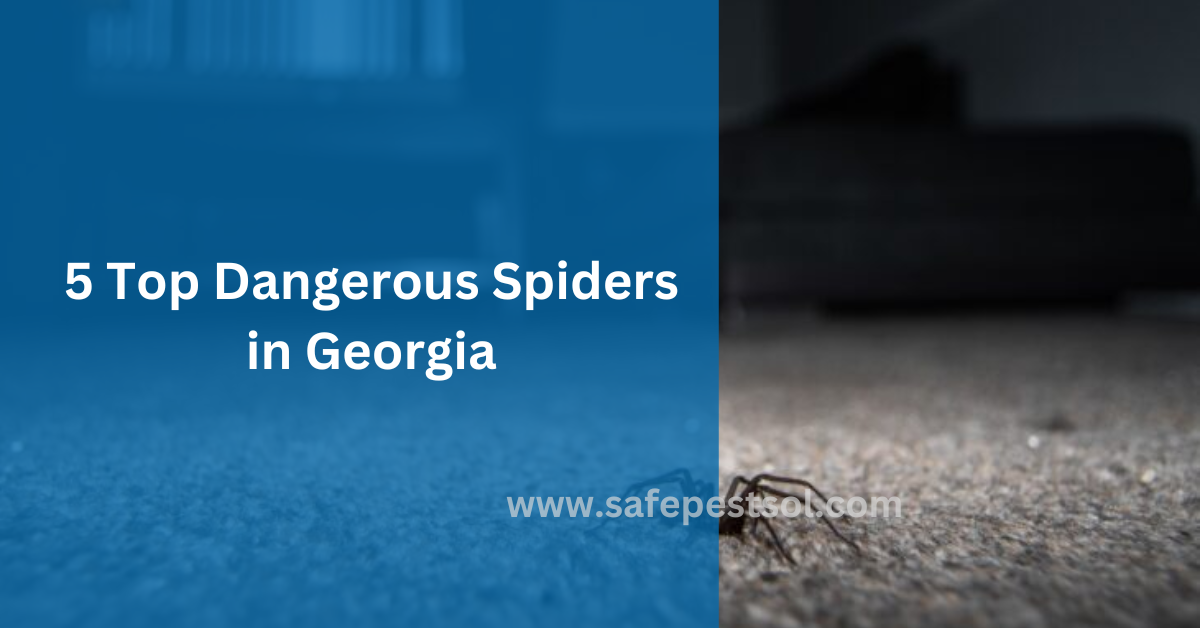Top 5 Most Dangerous Spiders in Georgia
Georgia is quite popular for fascinating animals that also include some of the most dangerous spiders. Most spiders are not a threat to human beings but their presence can be dangerous because of their venom.
Since such spiders bring a potential threat to homes, gardens, and other areas, it becomes important to know about them. The following blog discusses five of the top dangerous spiders in Georgia, their way of living, and tactics to keep them at bay.
5 Top Dangerous Spiders in Georgia
1. Southern Black Widow
Overview:
Southern Black Widow (Latrodectus mactans) is undoubtedly the most abundant poisonous spider in Georgia. They are well known for their glossy black body and most notably by a red hourglass sign on the abdomen. These can cause severe symptoms due to neurotoxic venom that directly acts on the nervous system.
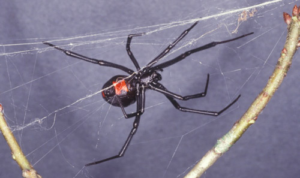
What Do They Eat?
The Southern Black Widow primarily feeds on various insects such as flies, mosquitoes, and grasshoppers. They design irregular sticky webs to catch the prey, usually in the dark, undisrupted places of sheds, garages, or gardens.
Life Cycle
A female black widow spider lays 200-300 eggs in silken sacs on average. These eggs spend about 20 days hatching into young spiderlings, which will develop to maturity within the next 2-4 months. Females can finish their life just within three years, while male black widow spiders live around 2-5 months.
Physical Features
| Feature | Description |
| Body Color | Shiny black with a red hourglass mark |
| Size | Females: 1.5 inches; Males: 0.75 inches |
| Web Type | Irregular, sticky webs |
| Habitat | Dark, secluded areas |
2. Northern Black Widow
Overview
This is another common venomous spider found in Georgia, especially in wooded areas; it looks the same as the southern type but with red or orange markings shaped into broken hourglasses.
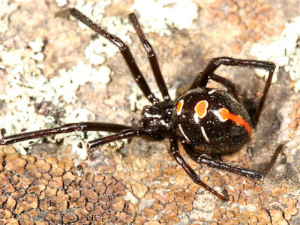
What Do They Eat?
This black widow spider also feeds on insects. It captures them on its strong, sticky web, often snaring moths, beetles, and small flying insects.
Life Cycle
Just like Southern Black Widow, Northen Black Widow have the same productive system. Their females can survive up to two years. On the other hand, males only live for 2-3 months once they mate.
Physical Features
| Feature | Description |
| Body Color | Black with broken red-orange hourglass mark |
| Size | Females: Up to 1.5 inches; Males: Smaller |
| Web Type | Irregular, sticky webs |
| Habitat | Wooded and damp areas |
3. Brown Recluse
Overview
The Brown Recluse is also named Loxosceles Reclusa. It is one of the most dangerous spiders found in the United States, including Georgia as well. This spider is light brown in color with violin shaped marking on its back. Its bite can cause a lot of pain and tissue damage and, in some very rare occasions, might require one to take a medical attention.
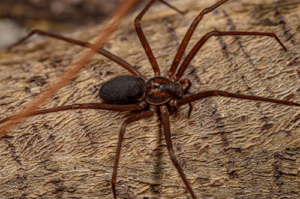
What Do They Eat?
It feeds mainly on small insects and other spiders. Since these spiders are nocturnal hunters, their speed and venom helps them catching prey instead of building webs.
Life Cycle
Brown Recluse lays about 30 to 40 eggs in cocoon-like sacs. Within a year, spiderlings reach maturity. They live mostly in the dim, quiet spots of basements and attics and have a lifecycle of about 1 or 2 years as adults.
Physical Features
| Feature | Description |
| Body Color | Light to dark brown |
| Marking | Violin-shaped marking on the back |
| Size | 0.25 to 0.75 inches |
| Habitat | Basements, attics, and closets |
4. Brown Widow
Overview
The Brown Widow Spider is from the same family as the black widow, but its neurotoxic venom is not as strong or potent. The brown widow has orange markings and spots on its tan-colored body and tan-colored legs. Its neurotoxic venom, though less potent than that of the Southern Black Widow, can be painful.
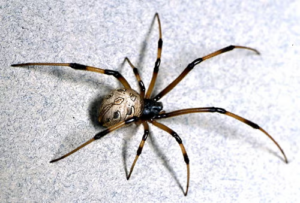
What Do They Eat?
The Brown Widow Spider eats insects, including ants, beetles, and flies. Like every other widow, it captures its prey using the strong web.
Life Cycle
Female Brown Widow spiders produce up to 120 eggs that are placed in spiked sacs. Spiderlings emerge within 20 days and take 2-3 months to mature. These spiders are found mostly on outdoor furniture, railings, and gardens.
Physical Features
| Feature | Description |
| Body Color | Tan to brown with orange spots |
| Size | 0.5 to 1 inch |
| Web Type | Strong, irregular webs |
| Habitat | Outdoor structures |
5. False Black Widow
Overview
Many people get confused between False Black Widow (Steatoda grossa), and an actual Black Widow. The difference is that Fake Black Widow have no red hourglass mark on the abdomen. It is less venomous but could still deliver a painful bite and show mild manifestations in humans.
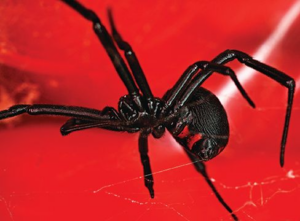
What Do They Eat?
Small insects are their diet. Sometimes, it may eat another spider. Moreover, False Black Widow builds a really tangled web in dark corners of houses and gardens.
Life Cycle
Normally, False Black Widow can lay up to 200 eggs in sacs. It takes a few weeks for these eggs to hatch. Once they hatched, it take 6-12 months for them to become mature. If the environment is secured, these spiders can live up to 5 years.
Physical Features
| Feature | Description |
| Body Color | Dark brown to black |
| Markings | None or faint white markings |
| Size | 0.25 to 0.5 inches |
| Habitat | Dark, sheltered areas |
5 Ways to Avoid Getting Bitten
Curious to know effective ways to get rid of spiders in your car, garden and home? Below are 5 tips for you:
1. Inspect Your Home
Check dark spaces like basements, under stairs, closets, and garages, where spiders may thrive to infest. Look for spider webs and egg sacks in corners, behind furniture, and unused storage spaces.
2. Wear Gloves
Remember to put on gloves whenever you are handling stored items outdoors or gardening, so no spiders accidentally come into contact with your skin. You should consider putting on thick gloves to avoid bites from hidden spiders in the soil or crevices.
3. Seal Openings
Block openings in doors, windows, and gaps on walls to prevent spiders from crawling inside your home. It is important to use weather stripping and caulk to seal cracks that might become entry points for these arachnids.
4. Avoid Dark Corners
Make sure there are less dark places and undisturbed areas which can become a shelter for spiders. Examine under furniture and behind appliances and especially in places that are not generally used or cleaned often.
5. Remove Webs
Eliminate spider webs as soon as possible with a broom or vacuum cleaner so that they will no longer come back to infest your house. Focus your cleaning on ceilings, corners, and outer structures such as the shed or porch where spider webs usually visit.
Conclusion
So, in this blog, we have discussed the five most dangerous spiders in Georgia that can be risky if encountered. However, being aware of them and knowing preventive measures can reduce the likelihood of being bitten by them. Always remember to be careful with encounters and seek professional help when suspecting infestations.
FAQs
Are spider bites very common in Georgia?
Such incidents are very rare. However these spiders can bite as well if they feel threatened. This is why alway take precautions to avoid their bites.
Which spider is the most venomous in Georgia?
Among all, the Southern Black Widow is recognized as the most dangerous spider in Georgia because it contains neurotoxic venom.
What should I do if bitten by a spider?
If you have gotten bitten by a spider, especially venomous spiders like brown recluse, consult a doctor as soon as possible.
Keep Your Space Safe From Spiders, Call Professionals Now!
While it is common, it can be dangerous to have spiders around you in Georgia. If you want to make yourself and your family secure from such spiders, call for our professional pest control services now.

